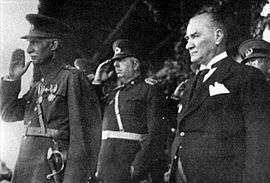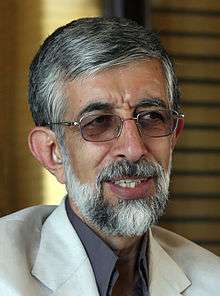Academy of Persian Language and Literature
 Logo of Academy of Persian Language and Literature | |
| Formation | May 20, 1935 |
|---|---|
| Purpose | regulatory body of the Persian language |
| Headquarters | Tehran, Iran |
Membership | Around 300 persons |
President | Gholam-Ali Haddad-Adel |
| Website | Academy of Persian Language and Literature website |
Iran's Academy of Persian Language and Literature (Persian: فرهنگستان زبان و ادب فارسی) formerly known as Academy of Iran (Persian: فرهنگستان ایران) is the official regulatory body of the Persian language, founded on May 20, 1935 by the initiative of Reza Shah and headquartered in Tehran, Iran. The academy acts as the official authority on the language, contributes to linguistic research on Persian and other languages of Iran.
History
The first academy of Persian language and literature was established in May 20, 1935, under the name Academy of Iran by the initiative of Reza Shah and mainly by Mohammad Ali Foroughi and Hekmat Shirazi, all prominent names in nationalism movement and the literature of the period, similar to Atatürk's Turkish Language Association in 1932. Ferdowsi in fact was a motivation behind Reza Shah, who established Iran's academy of Persian language and literature, in order to attempt to remove Arabic and French words from the Persian language, replacing them with suitable Persian alternatives. In 1934, Reza Shah ordered to rebuild Ferdowsi's tomb and set up a ceremony in Mashhad, Razavi Khorasan Province, celebrating a thousand years of Persian literature since the time of Ferdowsi, titled Ferdowsi Millenary Celebration (Persian: جشن هزاره فردوسی), inviting notable European as well as Iranian scholars.


Memorable names, notable literary figures and highly celebrated scholars were the members of the academy upon its foundation,[1] such as:
- Abbas Eqbal Ashtiani
- Abdolazim Gharib
- Ahmad Matin-Daftari
- Ali Akbar Dehkhoda
- Ali Akbar Siyasi
- Ali Asghar Hekmat
- Badiozzaman Forouzanfar
- Ebrahim Poordavood
- Homayun Foruzanfar
- Isa Sadiq
- Mahmoud Hessaby
- Mohammad Ali Foroughi
- Mohammad Ali Jamalzadeh
- Mohammad Ghazvini
- Mohammad Hejazi
- Mohammad Taghi Bahar
- Qasem Ghani
- Rashid Yasemi
- Said Nafisi
- Zabihollah Safa
Some international scholars were also involved, such as:[2]
- Arthur Christensen from Denmark
- Henry Masset from France
- Hussain Haykal from Egypt
- Raf'at Pasha from Egypt
- Professor Jan Rypka from Czechoslovakia
- Professor Muhammad-jan Shakuri from Tajikistan
- Abduqodir Maniyozov from Tajikistan
- Professor Dodikhudo Saymiddinov from Tajikistan
Previous language planning and regulating efforts
The first official attentions to the necessity of protection of the Persian language against foreign words, and to the standardization of the Persian orthography, were in 1871 in the age of Naser al-Din Shah Qajar. After Naser al-Din Shah, Mozaffar ad-Din Shah Qajar ordered the establishment of the first Persian association in 1903.[3] This academy declared officially that it used Persian and Arabic as acceptable sources for coining words. The ultimate goal of this association was to prevent books from being printed with wrong use of words. According to the executive guarantee of this association the government was responsible for wrongfully printed books. The words coined by this association, such as Rah Ahan (راه آهن) meaning 'railway', were printed in the Iran Soltani Newspaper, but after a lack of attention the association was closed.
A scientific association was founded in 1911. The achievement of this association was a dictionary called The words of scientific association (Persian: لغت انجمن علمی), which was completed in the future and was known by the name of Katouzian dictionary. [4]
Functions
The association heads the academic efforts for linguistic research on the Persian language and its sister languages of Iran.

The academy strives to protect the integrity of the Persian language and was a key institution in the struggle of the Iran to re-position itself as a nation-state after the collapse of the Qajar dynasty. During the 1930s and 1940s, it led massive campaigns to replace the many Arabic, Greek, and French loanwords whose immense use in the Persian language during the centuries preceding the foundation of the Pahlavi dynasty had created a literary language considerably different from the spoken Persian of the time.
Recently however, the attention of the academy has been turned towards the persistent infiltration of Persian, like many other languages, with English words, as a result of the globalization process. Since the 1980s, the academy constantly campaigns for the use of the Persian equivalents of these new English loanwords. It also has the task of linguistically deriving such words from existing Persian roots if no such equivalents exist, and actively promoting the adoption of these new coinages instead of their English equivalents in the daily lives of the Persian-speaking people in Iran, Afghanistan and Tajikistan.
The Academy's main activity has been creating and approving official Persian equivalents for the foreign general or technical terms. It has also created an official orthography of the Persian language, titled Persian Script Orthography (Persian: دستور خط فارسی). The academy also promotes research on Persian language and literature, other Iranian languages, studies and culture.
Iranian law requires those equivalents to be used in all official TV channels, radio stations, and communications of government bodies and government-owned companies, and in product names of all private companies.
Members of Academy

Academy's presidents to this day have been the late Hassan Habibi and Gholam Ali Haddad-Adel.
The academy members (permanent and associated) are selected from Masters of Persian literature and linguistics from Iran and other Persian speaking countries throughout the world as Tajikistan, Afghanistan and Uzbekistan. Up to 10 permanent chairs (out of 25 permanent chairs) have been devoted to non-Iranian nationals.
Current permanent members of the academy
Permanent members of the academy are as follows:[5]
Iranian
- Abdol Mohammad Ayati
- Hassan Anvari
- Nasrollah Pourjavadi
- Yadollah Samareh
- Gholam-Ali Haddad-Adel
- Bahaoddin Khorramshahi
- Mohammad Dabirmoghaddam
- Ali Roaghi
- Bahman Sarkarati
- Esmaeil Sa'dat
- Ahmad Samiei Gilani
- Ali-Ashraf Sadeghi
- Mahmood Abedi
- Kamran Fani
- Badrolzaman Gharib
- Fatollah Mojtabaei
- Mehdi Mohaghegh
- Houshang Moradi Kermani
- Hossein Masoumi Hamedani
- Mohhamad Ali Movahhed
- Abolhassan Najafi
- Salim Neysari
- Mohammad Jafar Yahaghi
Other
- Fazlollah Qodsi - Afghanistan
- Gholam Sarvar Homayoun - Afghanistan
- Mohammad Hossein Yamin - Afghanistan
Deceased members
- Abdolreza Houshang Mahdavi
- Qeysar Aminpour
- Ahmad Aram
- Ahmad Tafazzoli
- Javad Hadidi
- Mohammad Khansari
- Mohammad-Taghi Daneshpajouh
- Hamid Farzam
- Mohammad Mohit Tabatabaei
- Mostafa Mogharebi
- Abdolghader Meniasov - Tajikistan
- Muhammadjon Shakuri - Tajikistan
- Hassan Habibi
Announcement of the Academy about the name of the Persian language in Western languages
November 19, 2005 - The Academy of the Persian Language and Literature has delivered a pronouncement on the English name of the Persian language and rejected any usage of the word "Farsi" instead of Persian (en) / Persisch (de) / persa (es) / persan (fr) in the Western languages. The announcement reads:
- "Persian" has been used in a variety of publications including cultural, scientific and diplomatic documents for centuries and, therefore, it carries a very significant historical and cultural meaning. Hence, changing "Persian" to "Farsi" would negate this established important precedent.
- Changing the usage from "Persian" to "Farsi" may give the impression that Farsi is a new language, although this may well be the intention of some users of "Farsi".
- Changing the usage may also give the impression that Farsi is a dialect used in some parts of Iran rather than the predominant (and official) language of the country.
- The word "Farsi" has never been used in any research paper or university document in any Western language, and the proposal to begin using it would create doubt and ambiguity about the name of the official language of Iran.
Supporting this announcement, gradually other institutions and literary figures separately took similar actions throughout the world.[6][7][8][9]
See also
- Persian culture
- Persian language
- Iranian Studies
- Persian Studies
References
- ↑ 71st anniversary of the Academy of Persian Language and Literature (BBC Persian)
- ↑ Gozaresh-e Farhangestan Vadzeh, Tehran SH. 1317 / 1938
- ↑ "Farhangestan". Encyclopaedia Iranica. Encyclopaedia Iranica. Retrieved 3 October 2014.
- ↑ نگار داوری اردکانی (1389). برنامهریزی زبان فارسی. روایت فتح. p. 33. ISBN 978-600-6128-05-4.
- ↑ "فرهنگستان زبان و ادب فارسی". Persian Academy. Retrieved 23 December 2011.
- ↑ "Persian or Farsi?". Iranian. 16 December 1997. Retrieved 23 December 2011.
- ↑ "Fársi: 'Recently appeared language!'". Persiandirect. Retrieved 23 December 2011.
- ↑ "Persian or Fársi?". Persiandirect. Retrieved 23 December 2011.
- ↑ Samī‘ī Gīlānī, Aḥmad, ed. (Spring 1995). "متنِ اعلامِ نظرِ شورای فرهنگستانِ زبان و ادبِ فارسی دربارهی کاربردِ Farsi به جای Persian در مکاتباتِ وزارتِ امورِ خارجه" (PDF). The Quarterly Journal of the Academy of Persian Language and Literature (in Persian). Tehran. 1 (1): 152.
External links
- Official website of the Academy of Persian Language and Literature (Persian)
- AriaDic Persian/English Dictionary with pronunciation
- Forough Farrokhzad Poetry in English